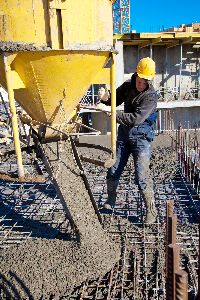3 Tips for Pouring Concrete in Cold Temperatures

Ready-mix concrete is easier to pour in warmer weather, but some projects can't wait until spring. While temperatures usually don’t drop below freezing in North Carolina, it can still get cold enough to compromise freshly poured concrete. Whether you’re building a driveway or hardscaping your yard, below are a few tips for protecting your new concrete.
How to Pour Concrete in Cold Weather
1. Don’t Pour Concrete on Frozen Ground
Frozen ground shifts and moves as it thaws, so fresh concrete will often crack as the ground settles. Concrete poured onto a cold surface will also cure evenly, potentially creating weak spots that can break when temperatures rise.

If the ground at your building site is frozen, use construction heaters or electric heaters to thaw the soil before pouring the concrete.
2. Warm Anything That Touches the Wet Concrete
Any object that touches the concrete should be warmed up to at least 32 degrees. This includes hand tools, trowels, embedments, and concrete forms. If temperatures aren’t going to drop below freezing before the pour, cover the ground with tarps the night before and store tools inside.
3. Keep the Concrete Warm
Freshly poured concrete must be kept above 50 degrees to cure properly. During the winter, you may have to apply thermal blankets over the wet ready-mix concrete or space heaters around the work area. Because curing can take several days, be ready to monitor temperatures around the concrete for an extended period.
Since 1984, Weeks Sand & Concrete has been the Sandhill Region's leading supplier of ready-mix concrete. Whether you’re remodeling your exterior spaces or building a new home, they’ll provide the high-quality materials and expertise you need. Visit their website to learn more about their ready-mix concrete and other products, or call (919) 499-4272 to place an order.
About the Business
Have a question? Ask the experts!
Send your question

